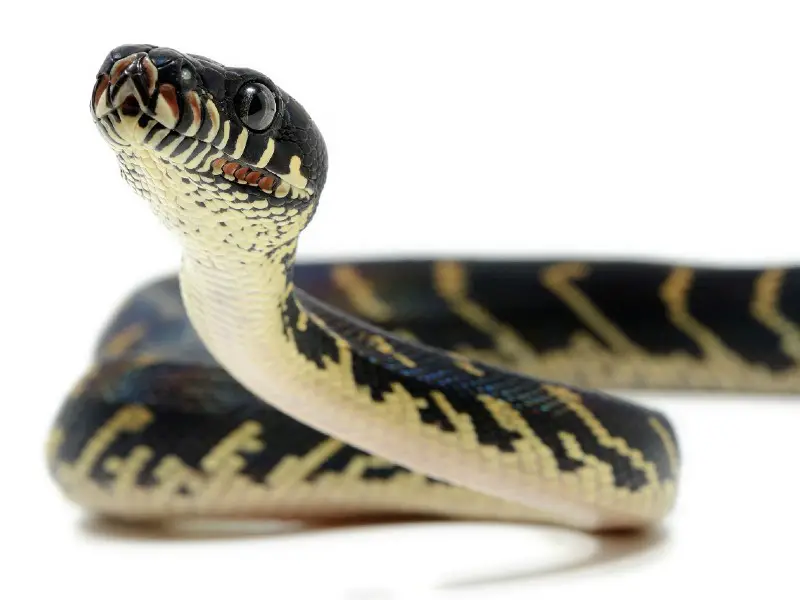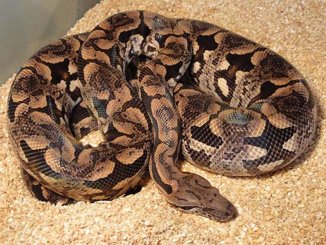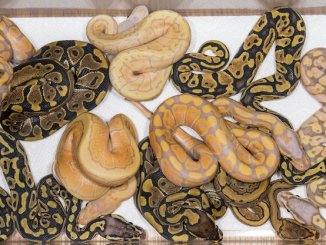The Boelen’s python is a snake native to New Guinea that is renowned as a beautiful and unique reptile.
Famous for their iridescent scales, Boelen’s pythons made a fantastic pet for any reptile lover. However, these snakes are fairly challenging, and should only be taken on by reasonably experienced snake owners. This article will discuss the important facts about Boelen’s pythons, and how to keep your python safe, happy, and comfortable.
Boelen’s Python Overview

Before taking home any new reptile, you should do plenty of research on the species. Even if you’ve owned a snake or reptile before, that doesn’t mean that you can properly care for a Boelen’s python.
| Species Facts | |
| Common Name | Boelen’s Python |
| Species Name | Simalia boeleni |
| Natural Habitat | Native to New Guinea, preferring mountainous regions |
| Adult Size | Approx. eight feet in length |
| Average Lifespan | 15–20 years |
| Diet | Small mammals, rodents, and birds |
| Housing | 6x3x2 enclosure, 68-85°F, approximately 90 °F for basking with an 80% humidity level |
| Experience level | Intermediate to advanced |
A Boelen’s python will grow to be a large reptile, with specific care needs. Never buy any pet if you can’t provide the necessary care. This is especially important for a large snake such as a python.
Origin
The Boelen’s python (Simalia boeleni) is found in the mid-mountain range of New Guinea, Indonesia. Boelen’s pythons are protected reptiles in their natural habitats, and it is illegal to hunt, kill, or export these snakes. Some Boelen pythons can be legally bought in other countries, although they are rare and very expensive.
Boelen’s pythons appear in Indonesian folklore, with one myth telling the story of a god with beautiful feathers fleeing from a fight, gradually shedding his feathers until all that was left was the black and white body of the python.
This story is one of the reasons why the locals of the New Guinea mountains are so protective of this rare and beautiful snake — the Boelen’s python has a firm place in local culture.
Appearance and Behavior
Boelen’s pythons are known for their famous black, iridescent scales. However, these snakes change in color and pattern as they age. Young pythons are red, with bands of white. As they age, the red gradually darkens to a sleek, iridescent black, with thin yellowish bands around the body and a yellowish belly.
There is no noticeable difference in appearance between males and females.
Size and Lifespan
Boelen’s pythons grow to an average length of eight feet. Some snakes can grow up to ten feet long, and there are rare cases of fourteen feet long Boelen’s pythons. These snakes also have significant girth.
A Boelen’s python is a long-term commitment, especially if you buy a young snake. These snakes live for around fifteen to twenty years and are long-term pets. Be sure that you’re ready to provide love and care for your pet for at least two decades.
Temperament
One noticeable feature of a Boelen’s python is its curiosity. This makes the Boelen’s python a reasonably friendly snake, which can be handled and picked up, although you will still need to be careful. Boelen’s pythons are calm snakes and tend not to be aggressive. If threatened, the python will hiss and display other warning signs, and ultimately will bite.
Boelen’s pythons aren’t venomous snakes, but they are large reptiles and can still deliver a nasty, painful bite.
Housing two snakes together is rarely a good idea. Two males or two females are likely to fight, and a male and female will either fight or breed.
Housing Boelen’s Pythons

Boelen’s pythons are large snakes and need plenty of room. While they mostly stick to the forest floor in their natural habitat, they are good climbers and need a little height in their enclosure. Natural substrates, burrows, and other hiding places are good decorations for your python enclosure. Make sure your snake has plenty of places to rest and hide.
Most snakes are masters of escape, and Boelen’s pythons are no different. A reptile terrarium should provide all the room your snake needs, and will close securely to prevent your curious reptile from escaping its enclosure.
Enclosure Size
An adult Boelen’s python needs a minimum of 6ft x 2ft x 2ft enclosure. Ideally, a 6ft x 2ft x 3ft will allow your snake a little extra climbing room. Your snake needs as much space as you can give them. With these reptiles growing to around eight feet in length, you should try and get an enclosure that allows your Boelen’s python to stretch out fully.
Enclosures of this size can be difficult to get because most reptile owners prefer smaller snakes, and large enclosures will be expensive. However, remember that your pet will be spending the rest of its life in this box, and it’s your responsibility to make sure they’re comfortable.
Lighting
A Boelen’s python requires special lighting. Full-spectrum UV lighting will keep your snake happy and healthy, with a proper day/night schedule. Setting your light on a timer for twelve hours on and twelve hours off will help your snake get into a proper photocycle rhythm. Be aware that rooms with lots of artificial or even natural light will disrupt this rhythm.
Temperature and Humidity
Proper heating is literally a life and death matter for your snake and needs to be set up and ready before you bring your snake home. A thermostat-controlled heating pad is one of the best ways to keep your terrarium warm enough.
You need three different areas in your snake’s enclosure, each with a different temperature:
- a cool side, at 68 degrees
- a warm side, at 85 degrees
- a basking area, at 90 degrees
A too-small enclosure will prevent the snake from regulating its own temperature, and it will overheat. You can adjust your heating pad to cover some parts of the enclosure but not others, creating your warmer and cooler areas. The cool side of the enclosure should contain a burrow or hiding place for your snake to hide and feel safe.
To create the warmest area of the enclosure, the basking area, use the heating pad and an overhead lighting bulb. Be sure that this bulb is protected. It will get very hot, and you don’t want your Boelen’s python — a notoriously curious snake — to accidentally burn itself.
Humidity levels in the enclosure should be 70–80%. You can keep the enclosure humid by lightly misting the decorations and substrate once or twice a day, or using an automatic misting machine. However, don’t mist too much, as this will encourage damp conditions, which causes mold and possible fungal infections in your snake.
Substrate and Decoration
The easiest substrate to use is newspaper, paper towels, or similar materials. These are cheap, easily accessible, and easy to clean. However, if you want to imitate your snake’s natural habitat as closely as possible and make your snake more comfortable (and also make the enclosure more appealing to look at), you can use other types of substrate, like aspen shavings, cypress mulch, or Coco fiber.
Avoid very dry substrates, as these can damage your snake’s scales. Additionally, pine and cedar shavings should be avoided at all costs, as this kind of substrate contains oils that will hurt your snake.
Stirring up or agitating the substrate daily prevents damp spots in the substrate. This helps to prevent bacterial growth or mold.
Hollow logs, caves, branches, rocks, and more are all good to decorate your enclosure. This kind of decoration most closely resembles a Boelen’s python’s natural habitat and gives the snake cool places to hide and relax. Adding sturdy branches for your snake to climb is also a good idea, especially if you have an enclosure with plenty of height.
You’ll also need a water bowl large enough for your snake to fit in and cool down.. Try not to overfill the bowl, as water will spill out over the sides and create more humidity in the enclosure. This water needs to be changed every day.
You should avoid overcrowding the enclosure, as this can stress out your snake. Always make sure that your decorations are safe for your snake to use, free from any colorings, oils, or chemicals that might hurt your pet. As always, make sure that there are no jagged edges or sharp points that could cause an injury.
Cleaning
Clean the full enclosure once a month. Spot cleaning the substrate weekly (removing wet patches, feces, etc.) will help you to keep up with the cleaning, and you can do a full enclosure clean once a month.
When you’re cleaning, it’s good to have a backup tank or a safe place to keep your snake. Never use commercial cleaning products, as these will hurt your snake. Use a snake-safe cleaning product, plenty of water, and sponges and brushes that you only use to clean out your snake enclosure.
You’ll need to completely replace all of the substrates and wash down the decorations. Then, clean the enclosure while it’s empty. Make sure the enclosure is completely dry before putting the substrate and the decorations back inside. If necessary, wait for the enclosure to warm up before replacing your snake.
Boelen’s Python Care

A Boelen’s python needs sufficient warmth, humidity, food, and space. However, this is not a beginner’s snake. A Boelen’s python is only recommended for reptile owners who have the experience, knowledge, and funds to buy and set up all the needed equipment.
Food and Water
You should change your Boelen’s python’s water bowl daily.
Boelen’s pythons eat mammals, rodents, and birds. Feed an adult snake live food like rabbits, quails, and guinea pigs. Baby Boelen’s pythons can be fed mice and rats. Juveniles can be fed one prey item every seven days.
Feed your python one prey item every ten days. This may not seem like a lot, but remember you will be feeding your snake a large meal. Boelen’s pythons are greedy animals, and will happily eat more if you let them. This can lead to an overweight, unhealthy snake.
Handling
Before you handle any reptile, you should thoroughly wash and sanitize your hands, both before and after. It’s safe to handle a Boelen’s python, as they are curious and intelligent snakes, and will quickly form a bond with you. However, handling a snake is a skill.
Even though Boelen’s pythons are large, they are still delicate. Never squeeze hard, and be sure to properly support your snake’s body. Active handling is recommended. This means that you allow the snake to move around and explore, without actually letting it go. If you just sit with your snake on your lap, your snake is going to get bored.
Never handle your snake for 24 hours before and 48 hours after a meal. Digestion is crucial for a snake, and stress can cause it to vomit up its food. Handle your snake at least once a week, but overhandling is not recommended.
Common Health Issues
Like any reptile, Boelen’s pythons are susceptible to parasites and other diseases. Here are a few to watch out for
Mites
Parasites are a common problem with snakes. Mites can be caused by a dirty enclosure or handling your snake with unsanitized hands. Always visit a vet to get mites treated. You can prevent mites in the first place by keeping the enclosure clean.
Respiratory issues
If the humidity levels are too high, your snake may develop an infection in its respiratory tract. You’ll notice mucus around the nose and mouth, and possibly bubbling and gurgling. Your snake will need immediate attention from a vet, and you should lower the humidity levels of the enclosure. Scale and mouth rot can also be caused by high humidity levels, as well as mold and fungal infections.
Obesity
It’s easy to overfeed a Boelen’s python, as these snakes love food and will happily eat whatever you give them. However, obesity puts pressure on the heart and liver, and if left untreated, your snake may die. If your Boelen’s python is overweight, you will need to put your snake on a diet or stick to a more structured feeding schedule.
Breeding
Your best chance for successfully breeding Boelen’s pythons is to imitate their natural breeding in the wild.
- Lower the enclosure temperature to around 60 °F for around three months, and gradually increase the humidity to 85%. This imitates the winter months the snake would experience in the wild, with colder weather and heavier rainfall.
- After three months, gradually increase the temperature and decrease the humidity to normal levels.
- Add the male to the female’s enclosure. Leave the two snakes together for a week, watching them for signs of aggression.
- After a week, remove the male, feed both snakes, and reintroduce the male 48 hours after feeding.
- If breeding has been successful, the female will stop eating and you will notice a bulge in her belly. Remove the male.
- Once the female has laid eggs, remove the eggs. She won’t care for them anymore. Put the eggs in an incubator, at around 88 °F, with a humidity level of 85-90%.
- Once the eggs hatch, don’t house the babies together. You should also avoid handling them right now, as they are young and fragile.
Breeding success may depend on your own experience, as well as the individual personalities and experience of your pythons.
Choosing and Buying A Boelen’s Python
Boelen’s pythons are not easy to find. They are rare snakes and tend to be expensive. A Boelen’s python may cost around $3500, not including its enclosure, equipment, medical needs, and food. This kind of rare animal is sometimes taken out of its home country illegally, so make sure that you’re buying from a reputable pet store, preferably one that specializes in reptiles and snakes.
It is illegal to take Boelen’s pythons from their natural habitats, and you will likely not be able to take them out of the country.
When you choose a Boelen’s python, look for one that seems healthy, active, and happy. Remember, these snakes should be curious, but can also be somewhat timid.
In all, Boelen’s pythons are beautiful, unique, and curious animals. They can make wonderful pets, but only for experienced snake owners.




